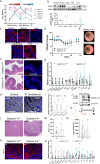Intestinal epithelial Gasdermin C is induced by IL-4R/STAT6 signaling but is dispensable for gut immune homeostasis
- PMID: 39489845
- PMCID: PMC11532336
- DOI: 10.1038/s41598-024-78336-z
Intestinal epithelial Gasdermin C is induced by IL-4R/STAT6 signaling but is dispensable for gut immune homeostasis
Abstract
Gasdermin C is one of the least studied members of the gasdermin family of proteins, known for their critical involvement in pyroptosis and host defense. Furthermore, evidence for the role of Gasdermin C in the intestine is scarce and partly controversial. Here, we tested the functional role of Gasdermin C in intestinal homeostasis, inflammation and tumorigenesis. : We studied Gasdermin C in response to cytokines in intestinal organoids. We evaluated epithelial differentiation, cell death and immune infiltration under steady state conditions in a new mouse line deficient in Gasdermin C. The role of Gasdermin C was analyzed in acute colitis, infection and colitis-associated cancer. Gasdemin C is highly expressed in the intestinal epithelium and strongly induced by the type 2 cytokines IL-4 and IL-13 in a STAT6-dependent manner. Gasdermin C-deficient mice show no changes in tissue architecture and epithelial homeostasis. Epithelial organoids deficient in Gasdermin C develop normally and show no alterations in proliferation or cell death. No changes were found in models of acute colitis, type 2 intestinal infection and colitis-associated cancer. Gasdermin C genes are upregulated by type 2 immunity, yet appear dispensable for the development of intestinal inflammation, infection and colitis-associated cancer.
Keywords: Gasdermin; Gut pathology; Intestinal homeostasis.
© 2024. The Author(s).
Conflict of interest statement
The authors declare no competing interests.
Figures




References
-
- Tan, G., Huang, C., Chen, J., Chen, B. & Zhi, F. Gasdermin-E-mediated pyroptosis participates in the pathogenesis of Crohn’s disease by promoting intestinal inflammation. Cell. Rep.35, 109265. 10.1016/j.celrep.2021.109265 (2021). - PubMed
MeSH terms
Substances
Grants and funding
LinkOut - more resources
Full Text Sources
Research Materials
Miscellaneous

